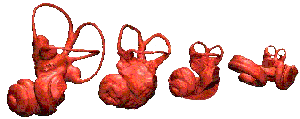|
The cladogram depicting whale evolution is from the book Evolution: The Triumph of an Idea by Carl Zimmer. The artwork is a slight modification of the illustration by Carl Buell
in At the Water's Edge by Zimmer. The book is a companion to the PBS series of the Evolution Project, a coproduction of the WGNH/NOVA Science Unit and Clear Blue Sky Productions.
Please visit the extensive website for this production.
|
It was not until 1979 that paleontologists had their first indisputable evidence about whale transition. Pakicetus was discovered by Philip Gingerich in Pakistan. Later, in 1995,
Hans Thewissen found Ambulocetus. Whales with legs are now known from Pakistan, India, Egypt and the U.S.A.
It took less than 15 million years for the whale lineage to move from land, through shallow bays and coastal waters, to deep marine environments. By 40 million years ago whales had become
essentially the animals we know today.
The evolution of whales involved much more than legs becoming flippers or vestigial organs. The fossil series demonstrates how their breathing apparatus changed, their ears changed and
other body parts changed. If you are interested in detailed taxonomic descriptions, click on an animal illustrated at right to be taken to another website with that information.
Whales did not turn into fish. Inside every flipper is found the bones of the mammalian hand. They swim like otters by undulating the mammalian spine. The tail fluke is not a fish fin.
Evolution works by modifying existing body plans to fit new conditions of life, and is often constrained by developmental pathways. No longer limited by gravity and strength of bones,
whales could become giants of the sea.
To learn more about whale evolution and the many transitional forms, use the hotlinks in the text above or in the bibliography given below.
|
|
|
As Stephen Gould concludes, "If you had given me a blank piece of paper and a blank check, I could not have drawn you a theoretical intermediate
any better or more convincing than Ambulocetus. Those dogmatists who by verbal trickery can make white black, and black white, will never be convinced of anything, but Ambulocetus
is the very animal that they proclaimed impossible in theory."
Natural History magazine, May 1994.
|
|
Researchers Discover Clues to Whale Evolution
Cetaceans have unique semicircular canals that allow them to be highly acrobatic swimmers without becoming dizzy.
By investigating this organ in ancient fossils, the researchers found that early whales acquired this special trait
quickly and early on in their evolution. This was a defining event that likely resulted in their total independence of life on land.
The research paper by Spoor F. et al., Vestibular Evidence for the Evolution of Aquatic Behaviour in early Cetaceans,
Nature 417:163-166 (2002), is available
here.
|
|

|
|
Side view of the inner ears of, left to right, a land mammal (bushbaby), a land-living early whale from Pakistan (
50-million-year-old Ichthyolestes), a marine early whale from India (45-million-year-old Indocetus), and a modern dolphin.
The latter two aquatic species have much smaller semicircular canals than the former two. Image reconstructed from computed
tomography scans, adjusting for body size differences between the animals. Each inner ear would easily fit on a penny.
[Image by F. Spoor]
|
|
|
|
Cetacean Evolution (Whales, Dolphins and Porpoises :
The indefatigable Ed Babinski has put together an incredible resource of up-to-date information of the emerging
picture of the evolution of cetaceans. Well worth a careful reading.
Origin of Whales from Early Artiodactyls :
P. D. Gingerich, et al., 21 Sept. 2026 in Science, pp. 2239-2242. Descriptions and skeletal drawings.
pdf file
Whale Origins Research:
The Thewissen Lab
Mark D. Uhen's Cetacean Research
Philip D. Gingerich: Research on the Origin and Early Evolution of Whales
PBS on Whale Evolution :
A 7-minute video describes two lines of evidence, fossil and molecular, which contribute to our
picture of evolution. It focuses on whales, which provide an excellent opportunity to examine the transition between
species because so many intermediate fossils have been found.
Cetacean Evolution : This site also provides you with complete background
information on every living species of whale, dolphin and porpoise known. Cetacea.org is currently on hiatus.
Estimated re-launch Spring-Summer 2026..
Ancient Walking Whales : Rodhocetus Sheds Light on Ancestry of Ocean Giants. National Geographic.
|
|
Thewissen, J. G. M (editor), 1998, The Emergence of Whales: Evolutionary Patterns in the Origin of Cetacea. Plenum Press:477 pages.
Berta, Annalisa and James L. Sumich, 1999, Marine Mammals: Evolutionary Biology. Academic Press:494 pages.
Tinker, Spencer Wilkie, 1988, Whales of the World. J. Brill:310 pages. [Hard to find, but the only guide to modern cetacea which describes the osteology]
Up-to-date information can be found in the Handbook of Marine Mammals, edited by S. H. Ridgeway and J. H. Harrison, published by Academic Press in 1981 and later. These are
horrendously expensive little volumes, but are the best source of data on all the marine mammals
|
|
Gingerich, P. D. 2026 . Cetacea. In K. D. Rose and J. D. Archibald (eds.), Placental mammals: origin, timing, and relationships of the major extant clades,
Johns Hopkins University Press, Baltimore, pp. 234-252. pdf file
Gingerich, P. D. 2026. Land-to-sea transition of early whales: evolution of Eocene Archaeoceti (Cetacea) in relation to skeletal proportions and locomotion of living semiaquatic mammals.
Paleobiology, 29: 429-454 abstract
River Dolphins Add Branches to Family Tree. by Dennis Normile. Science 2026 Mar. 30; 291: 2531-2532.
Origin of Whales from Early Artiodactyls by P. D. Gingerich etal. Science 2026, 293: 2239-2242.
pdf file
The Ancestry of Whales by Kenneth D. Rose. Science 2026, 293: 2216-2217.
Culture and Genetic Evolution in Whales. Science 1999 Jun. 25; 284: 2026
Whale Origins by Maureen A. O'Leary & John E. Heyning. Science 1999 Mar. 12; 283: 1641.
Whale Origins -- Conquering the Seas by John E. Heyning. Science 1999 Feb. 12; 283: 943.
New Views of the Origins of Mammals by Dennis Normile. Science 1998 Aug. 7; 281: 774-775.
Fossil Evidence for the Origin of Aquatic Locomotion in Archaeocete Whales.
by J. Thewissen, etal., Science 263:210-212, 1994.
Hind Limbs of Eocene Basilosaurus: Evidence of Feet in Whales.
by P. Gingerich, etal., Science 249: 154-157, 1990.
Origin of Whales in Epicontinental Remnant Seas. by P. Gingerich, etal., Science 220: 403-406, 1983.
Vestibular Evidence for the Evolution of Aquatic Behaviour in Early Cetaceans
by F. Spoor etal., Nature 417: 163-166, 09 May 2026. pdf file
Walking With Whales by Christian de Muizon, Nature 413: 259-260, 20 Sep 2026.
Evolution: In Search of the Whales' Sisters by Z. Luo, Nature 404: 235-239, 16 Mar. 2026.
Evolution of Cetacean Osmoregulation. by J. Thewissen, etal., Nature 381: 379-380, 1996.
New Whale from the Eocene of Pakistan and the Origin of Cetacean Swimming.
by P. Gingerich, etal., Nature 368: 844-847, 1994.
Origin of Underwater Hearing in Whales. by J. Thewissen & S. Hussain, Nature 361: 444-445, 1993.
Phylogenetic Aspects of Cetacean Origins: a Morphological Perspective.
by J. Thewissen, Journal of Mammalian Evolution 2: 157-184, 1994.
Origin of Whales & Role of Behavioral Changes in Terrestrial-aquatic Transition.
by M. O'Leary & M. Uhen, Paleobiology 25: 534-556, 1999.
A New Eocene Archaeocete from India and the Time of Origin of Whales.
by S. Bajpai & P. Gingerich, Proc. Nat. Acad. Sci. 95: 15464-15468, 1998.
Estimation of Time of Origin of Cetacea & Time of Divergence of Cetacea & Artiodactyla.
by P. Gingerich & M. Uhen, 1998, Palaeontologica Electronica.
|



